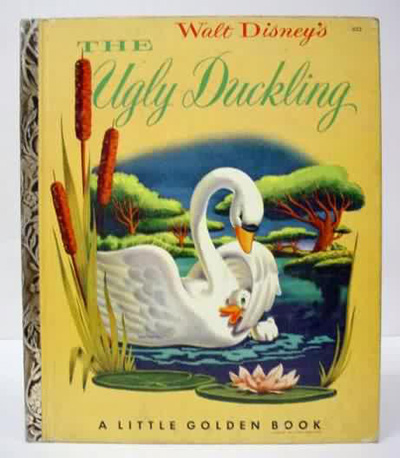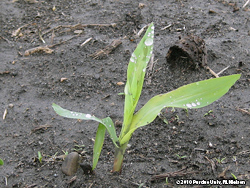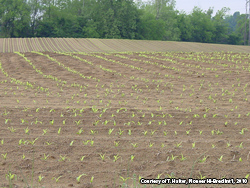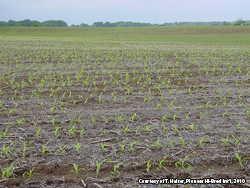May 2010
URL: http://www.kingcorn.org/news/timeless/UglyDuckling.html

Corn And The Ugly Duckling
R.L. (Bob) Nielsen
Agronomy Dept., Purdue Univ.
West Lafayette, IN 47907-2054
Email address: rnielsen
at purdue.edu
- Ugly ducklings can change into beautiful swans.
- The story needs re-telling every so often.
![]() very year, for the first five weeks or so after corn planting is
finished, the guys down at the Chat 'n Chew Cafe complain royally about the
looks of the crop. It does not matter whether it was an early planting season or a late planting season. Gripes about uneven stands, poor color, and slow growth
waft over the tables as everyone airs their concerns about the looks of
their neighbors' fields.
very year, for the first five weeks or so after corn planting is
finished, the guys down at the Chat 'n Chew Cafe complain royally about the
looks of the crop. It does not matter whether it was an early planting season or a late planting season. Gripes about uneven stands, poor color, and slow growth
waft over the tables as everyone airs their concerns about the looks of
their neighbors' fields.
Then suddenly one day, the tone of the conversation in between the coffee and sweet rolls perks up. Almost overnight, the crop has taken off like a rocket. The color of the leaves turns a dark, almost-blue green and they develop a distinct shine. From that point on, any connoisseur of corn feels better about life in general.
Why does this transition seem to happen over and over again every year?
During the first five weeks or so after planting, the corn plant is going about the business of creating all of the leaves it will ever have. A few of these leaves are visible, but most are wrapped tightly deep inside the whorl, biding their time until it is their turn to emerge.
Some root development is also occurring during these same first five weeks. In fact, the successful development of the first three or four sets of nodal roots during this time will go a long ways to ensuring successful stand establishment of the crop.
Even though new leaves and some roots are developing during this time, the rate of increase in total plant dry matter is relatively slow. The photosynthetic "factory" is small, as is the size of the raw material accumulator devices (aka, the roots).

A 2-leaf stage corn seedling with a yellow-green appearance indicative of 'crappy' growing conditions.
Up until about the three leaf stage (determined by number of visible leaf collars), corn seedlings are dependent primarily on the energy and nutrition reserves of the kernel to sustain their development. Beyond the three leaf stage, seedlings increasingly "wean" themselves from the kernel reserves and slowly become more dependent on the developing nodal root system.
READ THIS. During this important transition from dependence on kernel reserves to dependence on the nodal root system, corn seedlings are easily sidetracked when growing conditions are not adequate for maximum photosynthesis and rapid development of the nodal root system. Consequently, the appearance of corn seedlings during these early leaf stages can be downright ugly during extended periods of cloudy, cool weather. Throw in some excessively wet soils plus a little soil compaction plus a pinch of frost damage and you have a good start on a recipe for "crappy" stands of corn. The best remedy for most fields of yellow-green corn seedlings suffering from the effect of "crappy" growing conditions is the return of ample sunshine and warmth.
This period of transition during "crappy" growing conditions is exactly when that band of starter fertilizer you placed 2 inches over and 2 inches below the seed begins to pay for itself as the fledgling first nodal roots begin to tap into that fertilizer band sometime after the 2-leaf stage. Remember that prior to this leaf stage, young seedlings are relying primarily on the kernel reserves and do not use much additional soil nutrients. As the kernel reserves "play out" and the first few nodal roots tap into the starter band around the 2-leaf stage, the so-called "starter kick" begins to occur and seedling appearance will begin to improve by the 4- to 5-leaf stage of development.

Yellow-green corn seedlings; late V2 to early V3 stage of development.

Yellow-green corn seedlings; late V2 to early V3 stage of development.
The good news is that if the plants "hang in there" until they reach the five or six leaf stage, a miraculous turn of events usually occurs. The final leaf is created at the main growing point of the plant (near the top of the "pyramid" of stalk tissue) and the plant turns its attention toward developing the reproductive structures known as the tassel and ears.
At the same time, the size of the photosynthetic "factory" and its supporting staff of roots is reaching a critical mass that is finally capable of manufacturing greater and greater amounts of energy. With greater amounts of available energy, the "factory" begins to convert more and more of the incoming nutrients and carbon dioxide into sugars, starches, and other plant dry matter.
Subsequently, the stalk begins to elongate rapidly, the roots begin to develop rapidly, the tassel develops rapidly, the tiny ears within the ear shoots develop rapidly, and suddenly the plant is growing like wildfire. From about knee-high corn to the onset of pollination, the corn crop progresses through its most rapid growth phase (above- and below-ground), including the uptake of the lion's share of soil nutrients for use during the grain fill period.
By now you may be wondering what's the moral of this story?
Primarily, it's a reminder to take time once in a while to look at this King of Crops with a certain amount of awe and wonder.
Secondarily, be reminded that an ugly duckling of a corn crop that reaches the five to six leaf stage in reasonably good condition will usually turn the corner and become a beautiful swan of a corn crop during the next few weeks.
Thirdly, be reminded that true yield potential is just beginning to be determined at the start of this rapid growth phase. Ugly corn up to this point in time has not necessarily lost its yield potential. Ear size is determined from about knee-high to shoulder-high corn. Weather during pollination and grain fill finish off the yield determination.
While we often moan and complain about the looks of young corn, it often surprises us with acceptable yields in the fall.
Related References
Nielsen, RL (Bob). 2007. Ear Size Determination in Corn. Corny News Network, Purdue Univ. [online]. Available at http://www.kingcorn.org/news/timeless/EarSize.html [URL accessed May 2010].
Nielsen, RL (Bob). 2008. A Recipe for Crappy Stands of Corn. Corny News Network, Purdue Univ. [online] http://www.kingcorn.org/news/articles.08/CrappyRecipe-0422.html [URL accessed May 2010].
Nielsen, RL (Bob). 2008. Growing Points of Interest. Corny News Network, Purdue Univ. [online]. Available at http://www.kingcorn.org/news/timeless/GrowingPoints.html [URL accessed May 2010].
Nielsen, RL (Bob). 2010. Determining Corn Leaf Stages. Corny News Network, Purdue Univ. [online]. Available at http://www.kingcorn.org/news/timeless/VStageMethods.html [URL accessed May 2010].
Nielsen, RL (Bob). 2010. Root Development in Young Corn. Corny News Network, Purdue Univ. [online]. Available at http://www.kingcorn.org/news/timeless/Roots.html [URL accessed May 2010].

